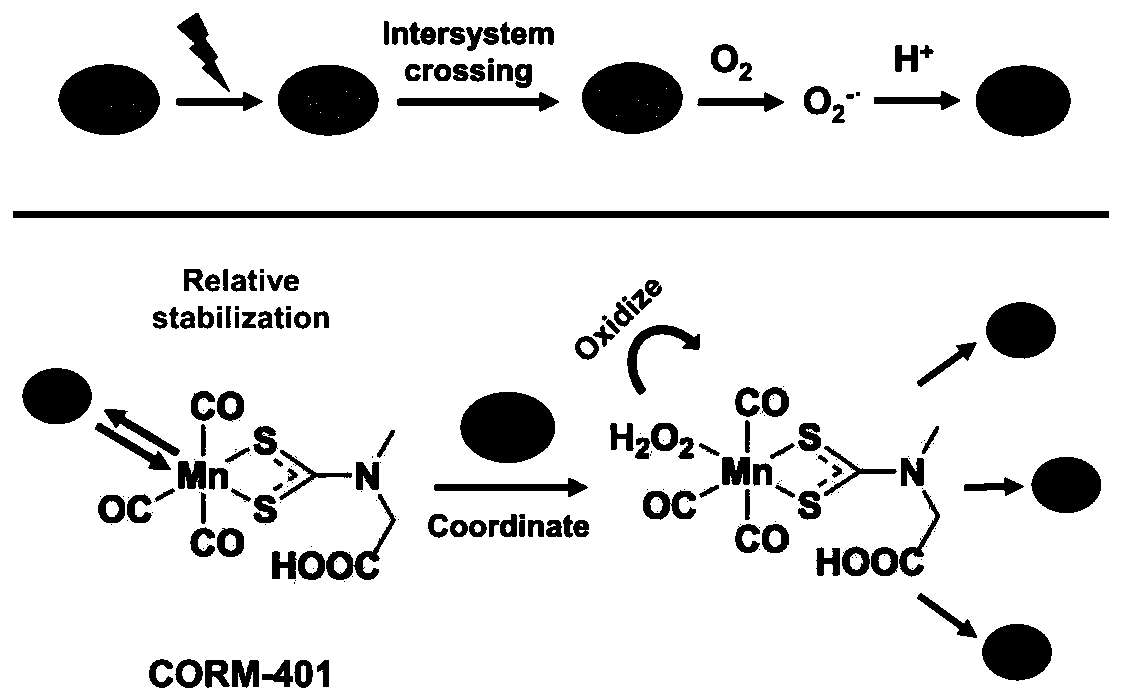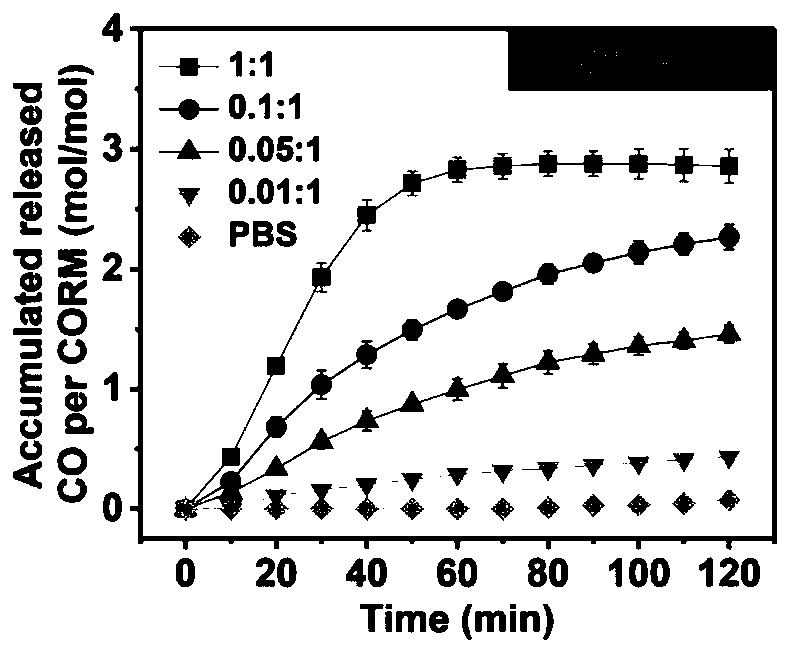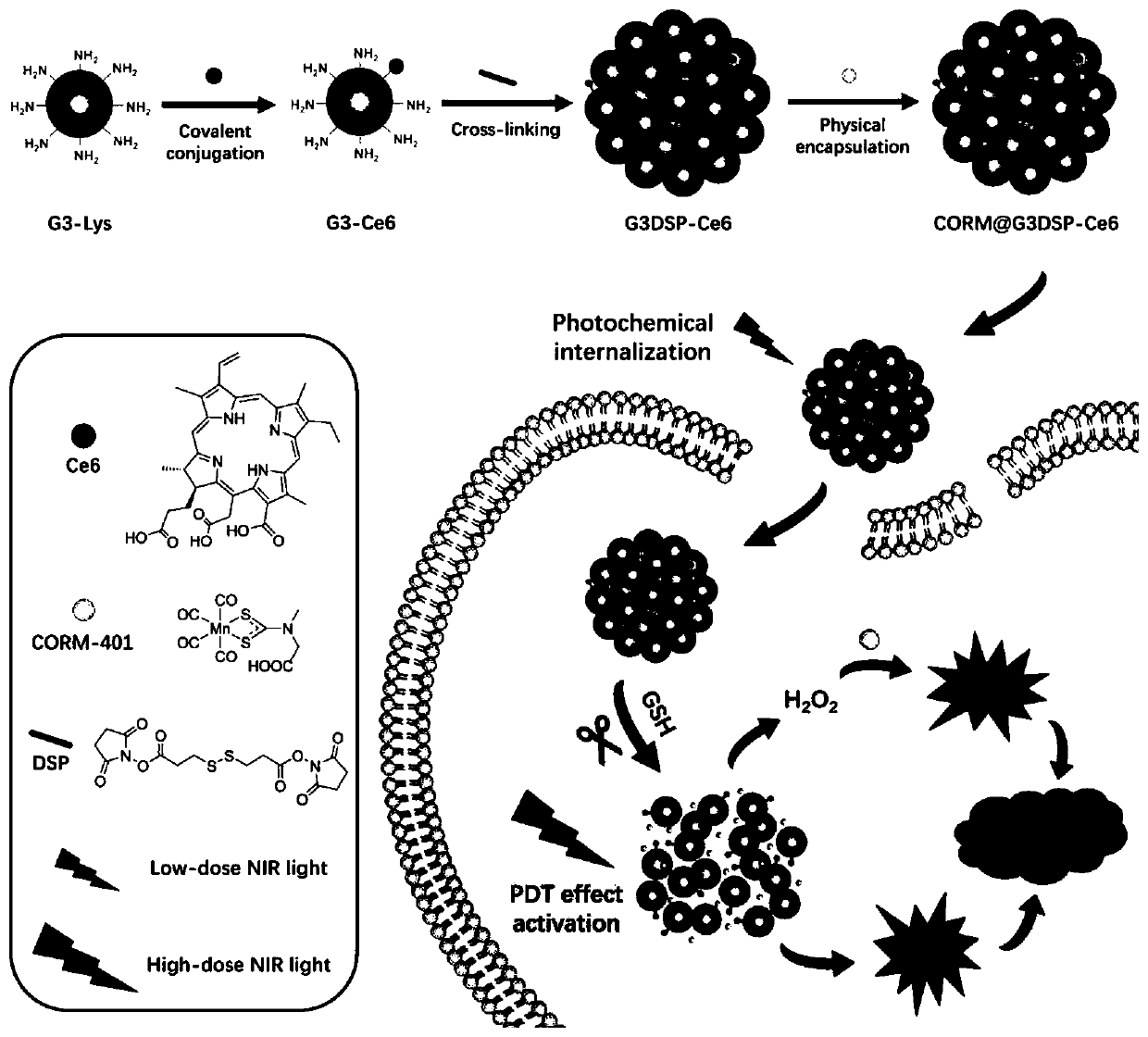Photodynamically induced co-controllable delivery system and its construction method
A delivery system, the technology of CORM-401, is applied in the field of photodynamically induced CO controllable delivery system and its construction, which can solve the problems of difficult-to-reach lesions, lack of targeting of gas, systemic toxicity, etc. Good in vitro and in vivo anti-tumor effect, good biosafety, and high CO release effect
- Summary
- Abstract
- Description
- Claims
- Application Information
AI Technical Summary
Problems solved by technology
Method used
Image
Examples
Embodiment 1
[0046] Feasibility study of a method for photodynamically induced release of CO.
[0047] Different concentrations of photosensitizer Ce6 and carbon monoxide releasing molecule CORM-401 (the concentration of CORM-401 was fixed at 1 mM, and the concentration ratio of Ce6 to CORM-401 was from 0.01:1 to 1:1) were dissolved in phosphate buffer at pH 7.4 ( PBS 7.4), and placed together with the CO gas detector in a transparent cylindrical separable airtight container, closed system. Near-infrared light at 665nm (optical energy density of 11.5 mW / cm 2 ) under continuous irradiation, record the concentration of CO by reading the readings of the CO gas detector at different time points, and calculate the amount of CO released by each CORM-401 molecule.
[0048] Assuming that both the gas phase and the liquid phase in the container reach equilibrium, and the pressure in the container is 1 standard atmospheric pressure, the amount of CO released by CORM-401 (N CO [mol]) is calculated ...
Embodiment 2
[0055] Construction of nanogel delivery system based on photodynamically induced CO release method.
[0056] The conjugate G3-Ce6 was synthesized through the covalent coupling reaction between the three-generation lysine dendrimer G3-Lys with POSS as the core and lysine as the branch unit and the photosensitizer Ce6. Specifically, under nitrogen protection, Ce6 (83.53mg, 0.14mmol) was mixed with N,N'-dicyclohexylcarbodiimide (DCC) (433.29mg, 2.10mmol), N-hydroxysuccinimide (NHS) (241.69mg, 2.10mmol) was dissolved in 10mL of anhydrous N,N-dimethylformamide (DMF), and reacted overnight at room temperature to activate the carboxyl group. After removing dicyclohexylurea (DCU) by filtration, the obtained Carboxylated Ce6 (Ce6-NHS) was slowly added dropwise to the G3-Lys (1.00g, 0.07mmol) solution, and reacted in the dark for 24h, and then the obtained solution was dialyzed against DMF and water sequentially (the molecular weight cut-off of the dialysis bag was 1000Da) Finally, fre...
Embodiment 3
[0064] A CO gas detector was used to detect the CO release behavior of CORM@G3DSP-Ce6. Continuously irradiate the CORM@G3DSP-Ce6 solution with 665nm near-infrared to keep the optical energy density at 11.5mW / cm 2 , to detect the release of CO.
[0065] To explore the mechanism of photodynamically induced CO release, the H produced by G3DSP-Ce6 and CORM@G3DSP-Ce6 solutions under light induction was detected using Amplex Red reagent and horseradish peroxidase (HRP). 2 o 2 concentration changes. Dissolve G3DSP-Ce6 (Ce6 concentration 0.68 μM) and CORM@G3DSP-Ce6 (Ce6 concentration 0.68 μM, CORM-401 concentration 10 μM) in PBS 7.4, respectively, and take 50 μL of the solution into a 96-well plate, and use a 665 nm near After the infrared light continuously irradiates the solution (the whole process keeps the light energy density at 11.5mW / cm 2 ), add 50 μL of Amplex Red (100 μM) and HRP (0.2 U / mL) working solution to each well, and measure the fluorescence value of each well wit...
PUM
| Property | Measurement | Unit |
|---|---|---|
| particle diameter | aaaaa | aaaaa |
| size | aaaaa | aaaaa |
Abstract
Description
Claims
Application Information
 Login to View More
Login to View More - R&D
- Intellectual Property
- Life Sciences
- Materials
- Tech Scout
- Unparalleled Data Quality
- Higher Quality Content
- 60% Fewer Hallucinations
Browse by: Latest US Patents, China's latest patents, Technical Efficacy Thesaurus, Application Domain, Technology Topic, Popular Technical Reports.
© 2025 PatSnap. All rights reserved.Legal|Privacy policy|Modern Slavery Act Transparency Statement|Sitemap|About US| Contact US: help@patsnap.com



